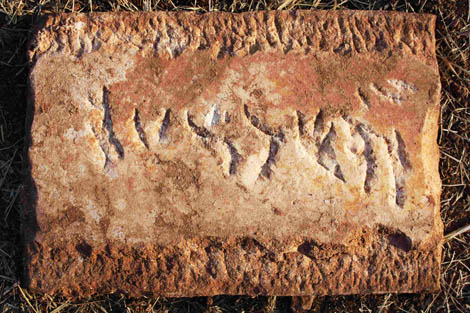 Archaeologists from the University of Friedrich-Schiller, in Jena (Germany), found near St. Bartholomew de Messines (Silves) the oldest archaeological evidence of Jewish culture in the Iberian Peninsula, during the last campaign of excavations carried out.
Archaeologists from the University of Friedrich-Schiller, in Jena (Germany), found near St. Bartholomew de Messines (Silves) the oldest archaeological evidence of Jewish culture in the Iberian Peninsula, during the last campaign of excavations carried out.
On a 40cm x 60cm marble slab, the name “Yehiel“ can be read, followed by other letters that have not yet been deciphered. Archaeologists think it could be a funerary tombstone.
Through radiocarbon analyzes carried out on deer stalks found near the tombstone, it was possible to obtain a dating no later than the year 390 of the era of Christ.
According to the person in charge of the excavations, Dennis Graen, from the University of Jena, the oldest archaeological evidence associated with Jewish culture in present-day Portuguese territory is also a tombstone with an inscription in Latin and an engraving of a menorah (seven-branched candelabrum) dated from 482 AD (XNUMXth century). The oldest known Hebrew inscription dates from the XNUMXth or XNUMXth century.
Over the past three years, a team from the University of Jena has been excavating a Roman villa, discovered by Jorge Correia, a technician from the Municipality of Silves (during archaeological prospection work), near São Bartolomeu de Messines.
The project aims to study the economy of the inhabitants of Lusitania who lived in the Algarve Barrocal in Roman times.
In fact, the coastal area has already benefited from many studies, which is not the case with the barrocal and interior of the Algarve, which lack more in-depth studies.
The recent discovery adds another puzzle to the many that emerged during the investigations. “We were really looking forward to finding an inscription in Latin when we turned the slab,” says Henning Wabersich, a member of the team.
However, no inscriptions have been found to date and nothing is known about the identity of the inhabitants who lived here.
After a thorough analysis of the tombstone by several specialists, it was possible to recognize the writing that was on the slab, since the engraving of the characters does not present a careful work.
“While we were looking for experts between Jena and Jerusalem to decipher the script, we got a clue from Spain,” says Dennis Graen. “Jordi Casanovas Miro, from the Museu Nacional d'Art de Catalunya, Barcelona [a specialist in the field of Hebrew inscriptions from the Iberian Peninsula] – there is no doubt that the name “Yehiel” is read – a name that appears in the Bible”.
In this case, it is not only an exceptional dating, but also an unusual context. Never before has Jewish evidence been detected in a Roman villa, explains the Jena archaeologist.
During the Roman Empire, around the date of inscription, Jews habitually wrote in Latin, for fear of reprisals.
Hebrew, as found on the slab, is only used after the decline of Roman supremacy, respectively during the period of population migrations that occurred during the XNUMXth or XNUMXth century.
“We were surprised by the discovery of reminiscences of Romans – in this case, Romanized Lusitans and Jews living together in a rural context”, says Dennis Graen. “We thought that situations like these only occurred in an urban context”.
Generally, information regarding Jewish communities in the region comes mostly from scriptures. “During the Council of Elvira, around 300 AD, rules of conduct between Jews and Christians were issued. This leads us to believe that, in the Iberian Peninsula, the Jewish population would already be quite numerous”, explains Dennis Graen – but the archaeological evidence remains lacking.
“We are aware of the presence of a Jewish community in the city of Silves during the Middle Ages. This community was present until the expulsion of the Jews in the year 1496”.
Next summer, Jena archaeologists will resume work. To date, about 160 meters of the Roman villa have been excavated, although most of the structures are still covered.
“We want to know more about the people who have lived here,” explains Graen. "Of course we want to answer the questions inherent in the Hebrew inscription."
The Municipality of Silves supported this team of archaeologists throughout their campaigns. Accommodation of personnel involved in the excavations, technical support in the areas of topography, treatment of materials, consultancy, cleaning and preventive conservation of fragile materials were some of the actions in which the municipality collaborated.


















Comments